
We investigate the dependence of the magnetic anisotropy and magnetic moments in surface-supported nanostructures on local atomic coordination, structure size, substrate material and orientation, and the interaction with molecular ligands. Since the relevant length scale of the exchange interaction is only a few atomic distances, magnetic materials must be engineered down to the sub-nanometer scale to make coordination and size effects observable. The synthesis of surface-supported nanostructures with atomic precision and unprecedented complexity is therefore an important part of our program. We study model nanostructures locally with low-temperature scanning probe microscopy and spectroscopy. Integral magnetic behavior is studied over large surface areas with magneto-optical Kerr effect as well as X-ray magnetic dichroism measurements. The combination of local and integral methods allows for a comprehensive characterization of the correlation between structure, the electronic properties and the magnetism.
- Surface Alloys
- Organic/Metal Interfaces
- Clusters on Surfaces
- Many-body Wavefunctions
- Thin Oxide Films
Key Publications:
Phys. Rev. Lett. 102, 067201, (2007)
Phys. Rev. B 79, 104430 (2009)

STM image of FePt surface alloy with atomic chemical contrast. The Fe atoms (yellow) are embedded in the Pt surface (bluish, not resolved), to form 2x1 and 2x2 superstructures. The 2x1 structure, visible as Fe chains separated by Pt, is the key to large magnetic anisotropy.
Stripes are Stars! Pt helps Fe to stay magnetized!
The magnetic anisotropy energy is among the most important functional properties of magnetic elements. It determines the orientation and stability of the magnetization as well as the mechanisms and the dynamics of the magnetization reversal. New materials with extremely large anisotropy values are currently sought for the development of ultrahigh density magnetic recording media. As one example, FePt or CoPt alloys exhibiting L10 structure are currently in the focus of intensive research, as they were found to exhibit unprecedented anisotropy values. It was recently discovered that also atomically small nanostructures of Fe and Pt can, under certain conditions, exhibit magnetic anisotropy values similar to those of their L10 bulk counterparts. This discovery was possible after advances in nanostructure synthesis have been made to embed Fe atoms as monatomic Fe stripes or in other configurations into the surface of Pt single crystals. It was found that the Pt plays a critical role in the magnetism of these structures, as it dictates the structure's magnetic anisotropy and thus helps the Fe to stay magnetized. Intriguingly, in the system studied, the interatomic exchange, magneto-crystalline anisotropy and Dzyaloshinski-Moriya interactions are all of the same order of magnitude, which leads to an interesting nanoscale interplay between ordinary magnetization states and noncollinear spin structures and hence to rather complex magnetic properties of the FePt nanostructures.
Collaborators:
A. Enders, R. Skomski
Nebraska MRSEC
J. Honolka, K. Kern, K. Fauth, G. Schuetz
MPI Stuttgart, Germany
P. Varga
TU Vienna, Austria
H. Ebert
LMU Muenchen, Germany
Key Publications:
J. Chem. Phys. C 114, 9408-9415 (2010)
"Surface state engineering of molecule-molecule interactions", arXiv:1107.0306
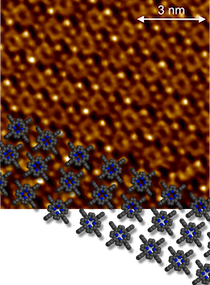
STM image of an island of porphyrin molecules on a Ag(111) substrate.
Interactions at the organics/metal interface
Designing molecular architectures in reduced dimensions is a potentially elegant and versatile approach towards the nanoscale control of complex matter. It allows scientists to engineer, atom-by-atom, molecule-by-molecule, highly organized systems with desired properties ranging from hydrogen storage and molecular switching to magnetic ordering. Porphyrin molecules are of particular interest because many different metal atoms can be inserted into the porphyrin ring, offering a wealth of possibilities to control, characterize and optimize properties. In our research, we create and analyze two-dimensionally ordered networks of porphyrin with various species of central metal atoms. The two-dimensional character of the structures allows us to probe the electronic and magnetic properties of individual elements within the networks. Our objective is to determine the interactions between the central metal atoms, such as Ni or Co, and the substrate (Ag or Pt), which can potentially result in magnetic ordering or useful catalytic properties.
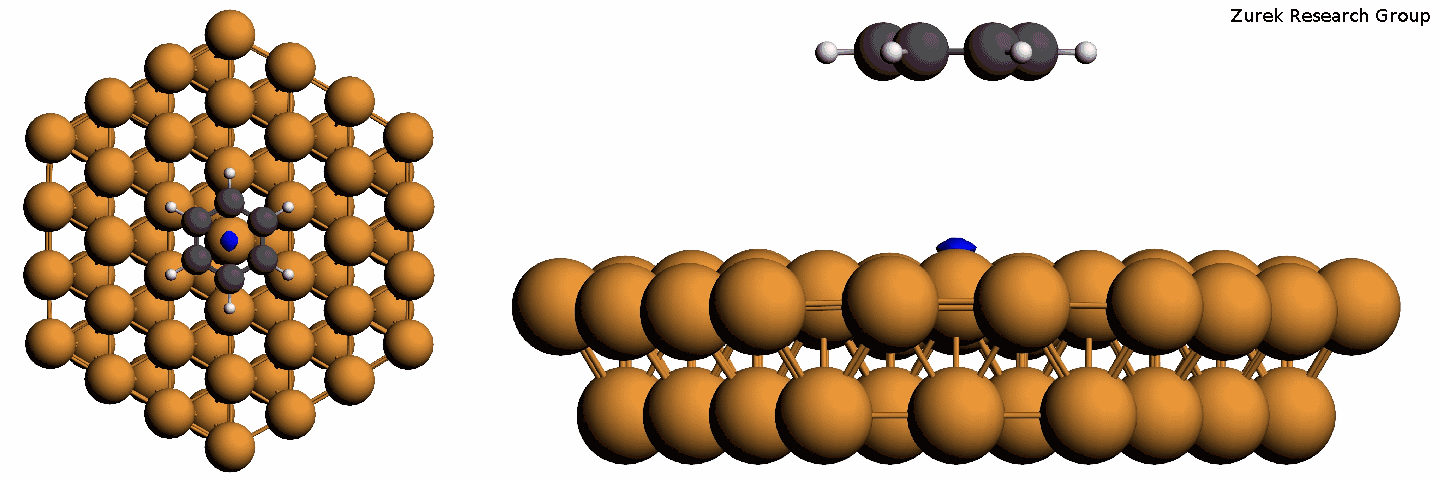
Animation of the formation of the pillow effect of surface charges as a benzene approaches a Cu(111) surface. Calculations: E. Zurek and S. Simpson, SUNY Buffalo.
Collaborators:
G. Rojas, D. Kunkel, J. Nitz, X. Chen, and A. Enders
Nebraska MRSEC
X. C. Zeng
UNL Chemistry
S. Simpson and E. Zurek
Chemistry, SUNY Buffalo
Key Publications:
J. Phys: Condens. Matter 22 (43) 433001, 2010.
Phys. Rev. B 81, 195403 (2010)
Phys.Stat. Solidi B 247 (5) 1063-1068 (2010)
Phys. Rev. B. 78 (2008) 165430
Surf. Sci. Letters 602 (14) (2008) L95/p>
European Physical J. D 45, 515-520 (2007)
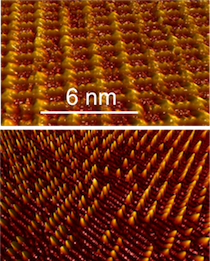
STM image of a carbon-induced reconstructed W(110) surface, exhibiting characteristic surface buckling (top). Co deposited on this W surface nucleates at the reconstruction sites, thereby forming an ordered cluster array (bottom)
Self-Assembled Clusters and Cluster/Substrate Interactions
The creation of nanostructures with well-defined geometry, chemistry, and long-range periodicity is a key challenge in nanomagnetism. This includes but is not limited to information technology, where progress will be based on nanoscale monodisperse and aligned magnetic units, densely packed into an ordered monolayer and with stable remanent magnetization at room temperature, accessible switching fields, and negligible interactions. In this project, we synthesize clusters of Co on mechanically stable, periodically corrugated boron-nitride layers by repeated cycles of buffer-layer-assisted growth. Alternatively, we employed reconstructed surfaces, such as carbureated W(110) surfaces, to achieve templating of deposited clusters. The approach combines the advantages of well-established preparation methods for surface-supported clusters, namely the versatility of cluster deposition from the gas phase and the positional accuracy of the directed growth on template surfaces. Our work showed that the approach to full coverage is critically slowed down by attractive inter-particle interaction, which results in the coalescence and growth of some of the clusters. Ordered cluster layers exhibiting 80 terra clusters per square inch, as those in this work, would be suitable for application as patterned media for ultrahigh density magnetic data storage if the Co particles could be replaced by aligned FePt particles.
Collaborators:
A. Enders, G. Rojas, X. Chen, R. Skomski
Nebraska MRSEC
X. Sabirianov
UN Omaha
Jihyun Kim and Jae-Sung Kim
Sook-Myung Women's University, Seoul (Korea)
Key Publications:
J. Phys: Condens. Matter 22 (43) 433001, 2010.
Chem. Phys. C 114, 9408-9415 (2010)
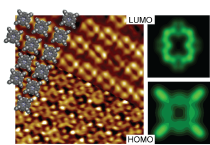
The figure shows STM pictures of the highest-occupied and lowest-unoccupied states and theoretical calculation of the STM brightness.
Visualization of Many-Body Wave Functions for Nanomagnetic Structures
Quantum mechanical calculations of nanoscale objects such as molecules and clusters help greatly in advancing our current understanding of materials and properties. They require, however, the consideration of the atomistic basis of such structures and usually result in challenging computations of many-body wave functions. We have combined state-of-the-art computational approaches with experiments to visualize quantum phenomena. We studied model systems such as tetraphenylporphyrin molecules designed to accommodate magnetic atoms. The high spatial precision of our scanning tunneling microscope (STM) is exploited to image selected molecular orbitals, thereby giving us a picture of many-body wave functions. The theoretical modeling of the STM images of these structures requires the consideration of a huge number of atoms. By comparing theory with experiment we are able to test important quantum-mechanical concepts, including the local partition-function theorem by Kohn and Yaniv, which shows that physical properties are largely determined on a local scale, even if the wave functions extend to infinity. Ultimately, this will help us understand how macroscopic properties emerge from quantum mechanics. This research is supported by the National Science Foundation, Division of Materials Research, Materials Research Sciences and Engineering Program, Grant 0820521.
Collaborators:
R. Skomski, G. Rojas, D. Kunkel, A. Enders, X.C. Zeng
Nebraska MRSEC
A. Solanki and A. Kashyap
Jaipur, India
S. Simpson and E. Zurek
Chemistry, SUNY Buffalo
Key Publications:
J. Phys: Condens. Matter 22 (43) 433001, 2010.
"Ultrathin BaTiO3 films as templates for multiferroics", New Journal of Physics, accepted 2011 (arXiv:1107.0902)
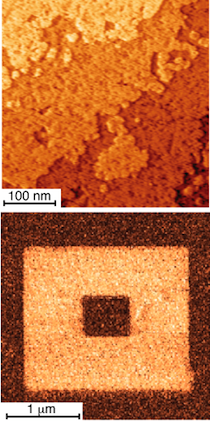
STM and piezoresponse force microscopy images of a 8 unit cell thin BaTiO3 film.
Functional Magnetic Structures in Contact with Oxide Surfaces
Thin oxide films are studied with regards to their ferroelectric and pyroelectric properties. But we are also interested how the electric polarization of those films changes the properties of deposited adsorbates, such as ferromagnetic nanostructures. One example of this work are deposited Fe nanoclusters clusters on ultrathin films of BaTiO3. Our goal is to establish a model system in which a recently proposed, new type of magneto-electric effect can be studied experimentally. This new effect, proposed by Tsymbal et al. arises at the Fe-BaTiO3 interface and is due to changes in the Fe-Ti bond length at the interface during reversal of the electric polarization of the oxide. This effect is thus distinctively different from commonly observed magneto-elastic coupling that is responsible for the majority of experimentally observed magnetoelectric effects. An experimental challenge is the growth of near-perfect metal-oxide interface, due to the tendency of the metal to oxidize at the interface. In our new approach we employ atomically smooth BaTiO3 thin films and deposit Fe clusters using buffer layer assisted growth, thereby reducing the chemical reactivity during deposition and improving the interface quality. First X-ray magnetic circular dichroism studies have shown that the magnetic moment of smallest clusters of Fe is not suppressed, which indicates that no oxide is formed. A spin reorientation transition from in-plane to out-of-plane is observed for a Fe coverage of 0.5 atomic layers. The high structural quality achieved is of great promise for the study of the atomistic origin of magneto-electric interface effects. Other projects concentrate on imaging the magnetism in ultrathin films of Cr2O3, or chromia. We employ spin-polarized scanning tunneling microscopy to make the layer-wise antiferromagnetism in epitaxial chromia films visible. Ultimately, the magnetism in those films is switchable with strong electric fields and we will perform such studies using the strong E-field produced by the tip of our STM. The ultimate goal of these projects is to explore avenues to magnetic switching with applied electrical fields.
Collaborators:
X. Chen, G. Rojas, A. Gruverman, A. Enders
Nebraska MRSEC
M. Bode, T. Santos, A. Bhattacharya
Argnonne National Laboratory
Jihyun Kim, Serlun Wang and Jae-Sung Kim
Sook-Myung Women's University, Seoul (Korea)